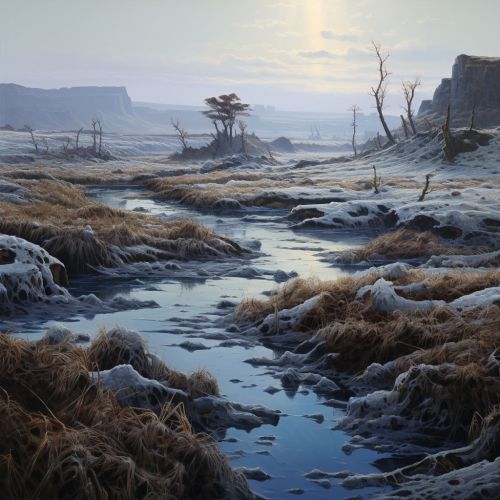Permafrost Thaw and Climate Feedbacks
Introduction
Permafrost, a term derived from the Latin words "perma" meaning permanent and "frost" referring to frozen ground, is a layer of soil, rock or sediment that remains at or below the freezing point of water for two or more consecutive years. It is a significant component of the cryosphere, covering approximately 24% of the land surface in the Northern Hemisphere. The thawing of permafrost due to increasing global temperatures is a significant concern as it has the potential to amplify global warming through positive feedback mechanisms. This article delves into the intricacies of permafrost thaw and its implications on climate feedbacks.


Permafrost Characteristics
Permafrost is characterized by its temperature, thickness, ice content, and the presence of talus deposits. The thickness of permafrost can range from less than a meter to more than 1500 meters in high-latitude regions. The ice content of permafrost is a crucial factor determining its sensitivity to thawing. High ice content makes permafrost more susceptible to thaw and subsequent ground subsidence.
Permafrost Distribution
Permafrost is predominantly found in the polar regions, but it also exists in lower latitudes on high mountain peaks. The largest expanses of permafrost are found in Siberia, Alaska, Canada, and Greenland. Smaller areas occur in the Andes, the Alps, the Rocky Mountains, and the Himalayas. The distribution of permafrost is primarily determined by climate, with air temperature and snow cover being the most influential factors.
Permafrost Thaw
Permafrost thaw refers to the process by which perennially frozen ground warms and transitions from a solid to a liquid state. This can occur due to natural climate variability or as a result of human-induced climate change. The thawing process can be gradual, known as thaw subsidence, or it can be abrupt, leading to the formation of thermokarst landscapes.
Climate Feedbacks
Climate feedbacks are processes that can either amplify (positive feedback) or diminish (negative feedback) the effects of climate forcings. In the context of permafrost, the primary feedbacks are positive and involve the release of greenhouse gases.
Greenhouse Gas Emissions
Permafrost contains large amounts of organic material that has been frozen for thousands of years. When permafrost thaws, this material decomposes and releases carbon dioxide (CO2) and methane (CH4), both potent greenhouse gases. This process, known as the permafrost carbon feedback, can significantly amplify global warming.
Permafrost Carbon Feedback
The permafrost carbon feedback (PCF) is a positive feedback loop. As the Earth's climate warms, permafrost thaws and releases stored carbon in the form of CO2 and CH4. These gases enhance the greenhouse effect, leading to further warming and more permafrost thaw. The PCF is a significant factor in global climate models, and its strength and timing are areas of ongoing research.
Implications of Permafrost Thaw
The implications of permafrost thaw are multifaceted, affecting ecosystems, human infrastructure, and the global climate. Thawing permafrost can lead to ground subsidence, damaging buildings and roads. It can also alter landscapes and disrupt ecosystems, affecting wildlife and plant species. On a global scale, the release of greenhouse gases from thawing permafrost can contribute to climate change.
Mitigation and Adaptation Strategies
Mitigation strategies aim to reduce greenhouse gas emissions from permafrost thaw, while adaptation strategies seek to minimize the impacts of thaw on human and natural systems. These strategies include reducing global greenhouse gas emissions, developing infrastructure that can withstand ground subsidence, and conserving permafrost habitats.
Conclusion
Permafrost thaw and its associated climate feedbacks present significant challenges for scientists, policymakers, and communities. Understanding these processes and their implications is crucial for developing effective strategies to mitigate and adapt to the impacts of climate change.
